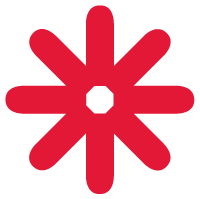Learning Outcomes are statements about students are expected to learn during an educational experience (be that a lesson, course, or a whole program).
There are excellent resources available for you to write Learning Outcomes, including from York's very own Teaching Commons. We recognize that while the principles of writing and working with Learning Outcomes are fairly straightforward, putting them to practice can be daunting.
Here, we provide you with an explanation of key elements in writing learning outcomes and how these elements can be applied to writing Program Learning Outcomes.
We have created a page for you to model how to map learning outcomes.
We have also created videos to support you with writing and mapping learning outcomes.


Writing your own Program Learning Outcomes (PLOs)?
Use this checklist to help you identify whether your Program Learning Outcomes (PLOs) achieve all the elements we've outlined below.
Learning Outcomes (for any level) should be:
Any learning outcome should be "SMART." That is they should be: Specific, Measurable, Achievable, Relevant, and Time-Bound.
A learning outcome should complete the sentence, "By the end of [lesson/course/program], students will/can/should....", and then represent a realistic element of what students will be able to know, do, and/or value at the end of their learning.
Click here for a useful document on writing SMART learning outcomes.

You may hear the name "Bloom" come up in conversations about learning outcomes.
Benjamin Bloom was an educational psychologist who developed a taxonomy of learning in the mid-20th century. His taxonomy, Bloom's Taxonomy, demonstrated scaffolded levels of learning to assist educators in articulating their educational objectives.
While the taxonomy is not without criticism, any Bloom's Taxonomy google search will provide you with a list of verbs representing each of the six taxonomic levels: Remembering, Understanding, Applying, Analyzing, Evaluating, and Creating.
Bloom's Taxonomy verb lists are useful when writing learning outcomes because they can help clarify the action of students' learning at the level you are expecting from them: Is this foundational knowledge the just need to remember? Or are you getting them to apply this knowledge and create something new from it?
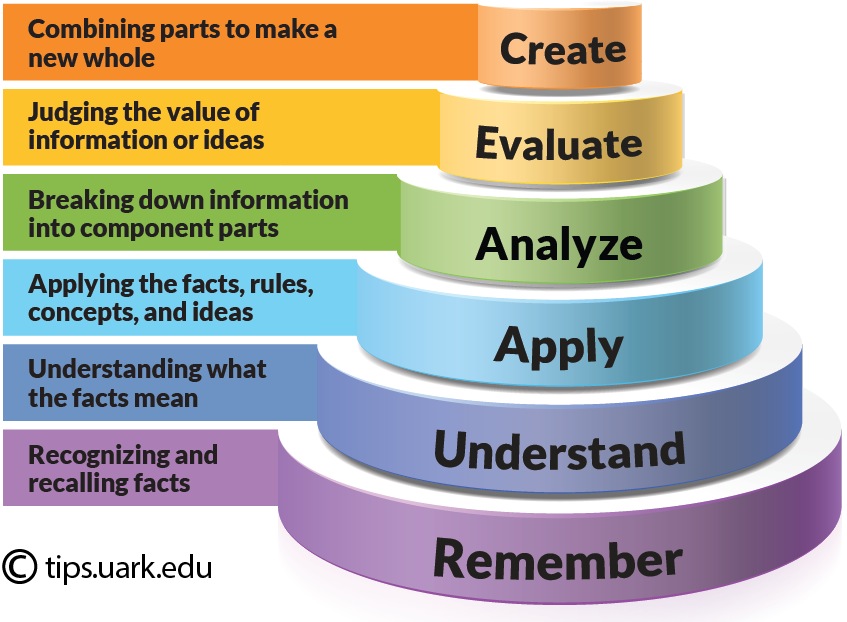
See a few of our favourite Bloom's lists from:
- University of Arkansas (related to writing LOs for courses and programs)
- Teach Thought (verbs useful for critical teaching activities)
- Utica University (a PDF of different verb lists)
- Loyalist College (verb list with aligned activities)
- Iowa State University (action verbs for course outcomes and objectives)
So many learning outcomes are drafted with the verb "understand": "By the end of this course, students will understand key factors leading to the coup overthrowing the Estado Novo regime in Portugal" or "By the end of the program, students will understand the role GIS plays in planning and development."
But what does "understand" mean? How will you know when "understanding" has happened?

| I'll know 'understanding' has happened when students can list factors related to.... | |
| Ok, then, say "List factors." "List" is a much stronger verb than "understand" and represents the first level of Bloom's taxonomy. | |
| I'll know 'understanding' has happened when students can identify what tool to use in different situations and apply that tool correctly. | |
| OK, then say "identify and apply to relevant situations." "Identify" and "apply" are great verbs and represent two levels of Bloom's taxonomy. | |
Articulating more direct actions (assisted by Bloom's Taxonomy) can provide greater clarity to both you and your students as to what you want students to know/do/value by the end of their educational activity(ies).
Learning Outcomes should represent a multifaceted articulation of what students should know, do, and value by the end of their learning.
If fact, if you're getting stuck in writing learning outcomes, ask yourself that very question: What do I want students to know, do, and/or value by the end of their learning experience? This list is the start, and maybe even the end, of your learning outcomes.
You can use a tool like Google Jamboard to brainstorm the know/do/value elements. This tool is especially useful when brainstorming these elements with colleagues.
Here is a template of what a brainstorming document might look like for you.
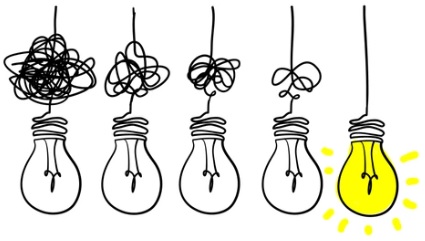
This video can support attributes described above.
Program Learning Outcomes should also be:
If your Program Learning Outcomes (PLOs) were created more than five years ago, you might have a long list of PLOs that don't represent your program's uniqueness.
These longer lists were from a different "generation" of PLOs that were written as more of an inventory for meeting the Degree Level Expectations (DLEs) than a reflection of a program's uniqueness.
We have come to recognize that these lists are not very useful for communicating learning outcomes to students or applying program goals to courses.
Thus, we've moved to advocating for a more concise list of PLOs: a list of PLOs that better reflect your program and can be both communicated and used by students and faculty alike. These PLOs meet Ontario's Degree Level Expectations but are not dictated by them.
An ideal set of PLOs would number eight to twelve and reflect scaffolded knowledge, skills, and values across your program. Our curriculum maps are designed for a more concise set of PLOs and you can find these on this site under resources.
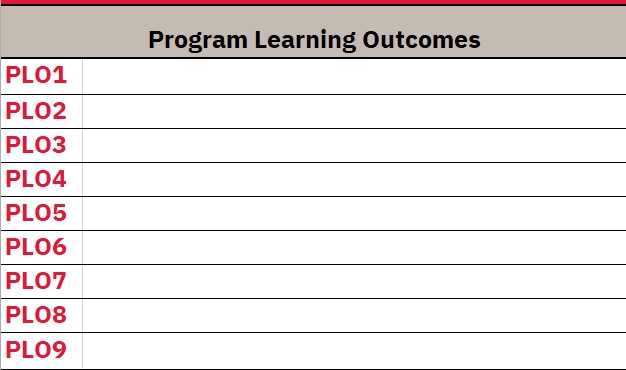
York's 2020-2025 Academic Plan has identified six key priorities:
- 21st Century Learning: Diversifying whom, what, and how we teach
- Knowledge for the Future: From creation to application
- From Access to Success: Next generation student supports
- Advancing Global Engagement
- Working in Partnership
- Living Well Together
We also have a commitment to addressing the UN Sustainable Development Goals (SDGs), a Framework and Action Plan on Black Inclusion, and the Indigenous Framework for York University.
These are all central elements of York's identity and can be part of your Program Learning Outcomes (PLOs) as well.
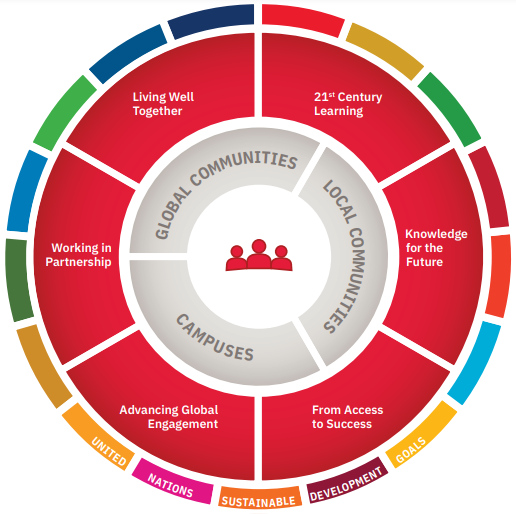
How might these elements show up in your PLOs? How do they show up in your program?
The older "generation" of PLOs provided a thorough list of key skills and knowledges that students would get through their program. However, these outcomes were often one dimensional and didn't reflect the nuances of students' unique experiences they would get here at York.

PLOs should demonstrate the uniqueness of your program!
- Does your program have streams or clusters of themed courses students choose from? Add those into your PLOs!
- Does your program have experiential elements that draw from the rich communities surrounding campus? Make sure those are mentioned!
- Are there content foci only you can offer because of expertise amongst your faculty? Include these in your outcomes!
Students can go anywhere for their degree. What makes your program at York stand out?
According to Quality Council, all PLOs have to be communicated to students. We specifically ask how that is done in the Cyclical Program Review Self Study. Often, programs will identify that the course learning outcomes are on all syllabi or that the program's website includes a program description. These are all useful communication points, but they are not directly communicating PLOs to students.
When there were dozens of PLOs, communicating them to students seemed overwhelming and awkward, but with a more concise and unique set of PLOs for your program, this communication can be more manageable.
However, when we are communicating PLOs to students, we also have to ensure they are written in ways that can be easily understood by students. Therefore, PLOs should be written in plain language with the audience (both novices/students and scholars/faculty in the area) in mind.
A good example of writing PLOs to communicate to students is the example shown by Morehouse College in Georgia.
For each program, Morehouse posts a list of easily understood Learning Outcomes.
These learning outcomes are actionable, multifaceted, and demonstrate different levels of learning.
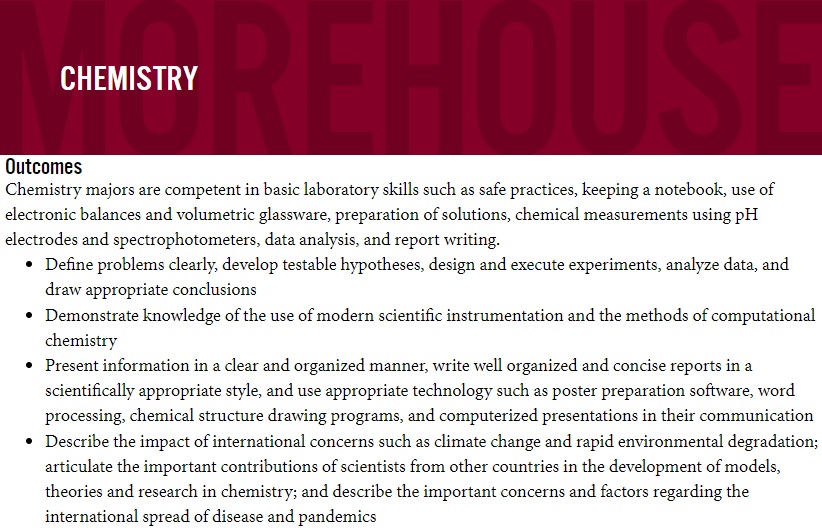
Worried that a list using plain language doesn't show enough of your program?
Continue to browse through Morehouse's website for additional examples of effective PLOs written in plain language.
Specifically, see this example of how Morehouse wrote and presented the Learning Outcomes for their General Education program. They wrote a concise, plain language set of PLOs that acted as a set of headings for more complex elements of each of the PLOs. Note that in this example both that the broad PLOs and their details were written in plain language for students to understand.
Learning Outcomes can have the reputation for being an administrative exercise not directly connected to the work of the classroom.
When there was a long list of broad PLOs, this disconnection was understandable because there was not enough depth to the PLOs to represent the complex experiences in your classroom.
However, Program Learning Outcomes should represent what is happening in the classroom, and the classroom should reflect what has been articulated as goals and outcomes for the program.
A professor should understand their course within the PLOs and the PLOs should reflect that course.
If a faculty member comes to teach a course, they should understand the objectives of this course is relation to the program: "I'm teaching ABCD 3003 and this course meets PLO2, PLO5, and PLO8. Therefore, I will organize my course to ensure that these elements are covered (and maybe assessed!) because of the ways this course fits into the overall program."
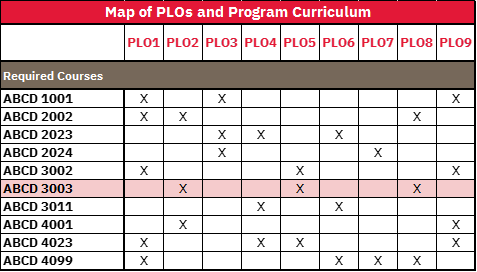

However, Program Learning Outcomes do not define the complete experience of a course.
A course should have their own Learning Outcomes that are SMART, demonstrate different levels of learning, actionable, multifaceted, and concise.
These course-level Learning Outcomes should be mapped to the Program Learning Outcomes, and course assignments should be direct realization of these Learning Outcomes. Course LOs can do more than the PLOs but course assignments should be a direct representation of course Outcomes.
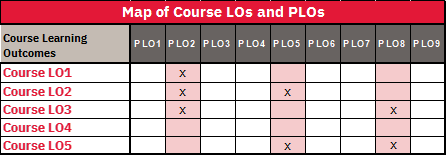
Note that Course LOs are unique to that course.
However, given that in this example, the program identified that this course meets PLOs 2, 3, and 8, then this table shows how the course LOs meet those PLOs. The course can do more than the PLOs, but they shouldn't do less.
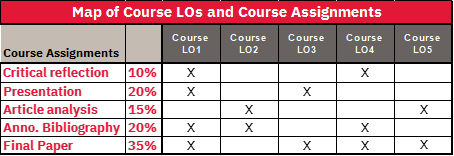
If the Course LOs have been mapped to PLOs, and assignments have been mapped to Course LOs, then it is easier to identify which individual course assignments can demonstrate program assessment.
How do we know when students meet the articulated Program Learning Outcomes? This is where PLO assessment comes in.
PLO assessment is not about individual grades or faculty performance. It is looking at specific program elements and identifying if a cohort of students are knowing and doing the things we want them to. (This is one of reasons we want to move away from learning outcomes that say students will "understand" something: How do we know they "understand"?)
We have provided information to help with assessment, but programs should also think about how regular PLO assessment might look like for them.
- Can there be key assessments in courses that are developed and discussed amongst many faculty?
- Can these findings and discussions be recorded and used to develop a plan for change?
- Is there a ways we can make sure that what we're teaching and what students are learning are in alignment?

These are questions that contribute to the ongoing health of a program and that your Faculty can help support.
See our Assessment page and video for more.
If you have an interesting assessment plan, or want to develop one, contact us to share.
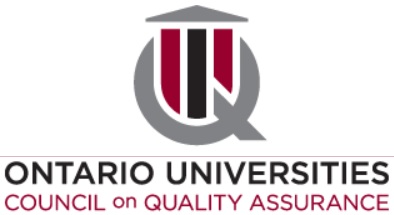
Ontario has identified six required qualities of an undergraduate degree and six required qualities of a graduate degree. Within each of those qualities is a description for different degree types (honours vs general; Master's vs Doctorate).
All of our programs must meet these Degree Level Expectations (DLEs).
However, these are the base-level expectations.
Our programs can do so much more. Our programs do so much more. Which is why we want to write and communicate unique PLOs that reflect the work we're doing in our classrooms; not PLOs that simply provide a description of these expectations.
To ensure that our PLOs meet the DLEs, have provided resources for mapping these relationships, including a video.
This video can support attributes described above.
Support Videos

Writing your own Program Learning Outcomes (PLOs)?
Use this checklist to help you identify whether your Program Learning Outcomes (PLOs) achieve all the elements we've outlined below.

